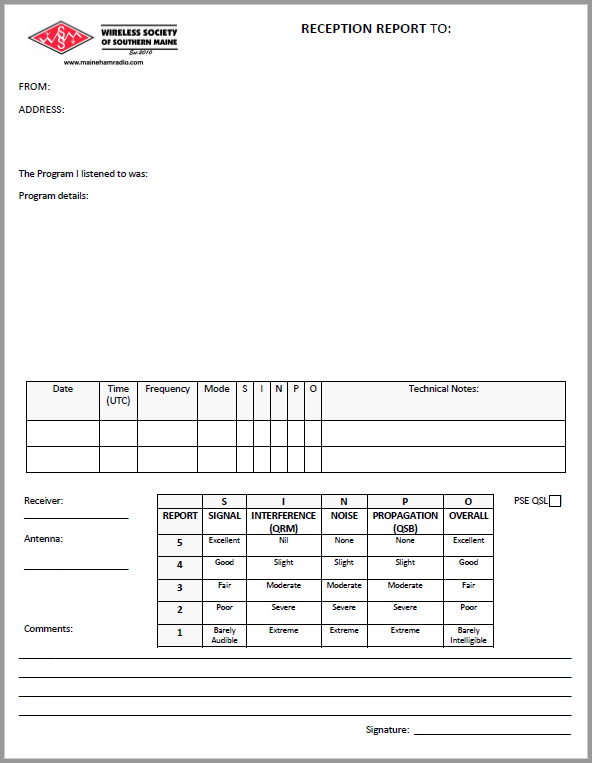Writing
Reception Reports
Many ham radio operators started
out in the hobby as shortwave listeners, so you may already be familiar
with
the components of writing a reception report, but in case you’re not,
here’s
some tips:
To
make things easier, we’ve
created a Reception Report form, downloadable as a fillable PDF or
basic print version:
Click here to
download and print
WSSM's Reception Report form.
Click here to
download an editable
Reception Report form.

Tips
for writing quality reception reports:
For
most international shortwave
stations like the Voice
of America, Radio
Romania International, Radio
Prague, Radio Slovakia
International,
and others, a point of contact (such as a General Manager), isn’t
necessary, since
they typically have departments that are dedicated to handling
reception
reports and listener correspondence.
Time
and Date
For
reports to international broadcasters, always use Universal Time
Coordinated (or UTC), in the standard 24-hour format, and be careful
that the
date also aligns with UTC. For example, if its 8:00 PM, August 24th
locally, it may be 0000 UTC, August 25th.
It’s
acceptable to use local time
of the station if the station you listened to is within your time zone.
Otherwise, always use UTC.
Reception
Details
The
“SINPO” (Strength,
Interference, Noise, Propagation, Overall) rating format of reporting
reception
quality is commonly used, although a more detailed narrative is also
welcome.
In amateur radio terminology, signal strength is what it shows on the S
meter,
if one is equipped), Interference is QRM, Noise is band noise, which is
what
hams call QRN, Propagation is fading, or QSB, and Overall is the
overall
assessment.
Formats
like SINPO are not usually recognized by domestic stations, so when
sending reports to them, it’s
best to also include a written description about
signal
quality, fading, interference from other stations, etc.
Include
Return Postage
Return
postage is always
appreciated, and in some cases, required. Uncancelled postage stamps
(valid in
the station’s own country) are effective. A good source for stamps for
other
countries is William Plum DX Supplies. If it’s
a stateside report, send a
self-addressed-stamped envelope. International Reply Coupons (or IRCs)
are also
accepted around the world, but they are no longer available in U.S.
post offices, so
you’d have to find an international source. In most cases, it’s okay to
send
one or two US Dollar bills.
Listening
and Taking Notes
A
common question is “How
long
should I listen?” Obviously, propagation can affect this, but
most stations
require 30 minutes to an hour.
Take
notes about the content that
you are listening to, but you don’t have to be exhaustive and capture
every
word. Many stations are more interested in what you think about
the
content than what you heard.
They know what they’re transmitting! Just
include enough information so they can verify that it was indeed their
station
that you were listening to and in some cases, align it with the time
and date that you heard
it.
For
domestic Mediumwave (AM), FM,
tropical band or other shortwave broadcasts meant for a local audience,
try to
address your report to a contact person (usually a General Manager or
Chief
Engineer). This information is available in publications such as the World
Radio Television Handbook, which is published annually,
or online searches.
Be
sure to note any local advertising
(commercials) if present. Why? Many stations stream on the Internet,
and the
station needs to know that you’re listening over the air, rather than
listening
to a stream. At least in the U.S., ads over internet streams are often
different than those broadcast over the air, and in some cases, there
are no
ads played on the stream.
Helpful
shortwave listening
resources:
- SWLing.com
- an online source for news, frequencies, schedules, and other
information related to the hobby of shortwave listening.
Shortwave broadcast schedules
and
frequencies can also be found on individual broadcaster’s websites.
Check out the links below for more info.
International
Broadcasters
Since
you're here, you may also be interested in: QSLing